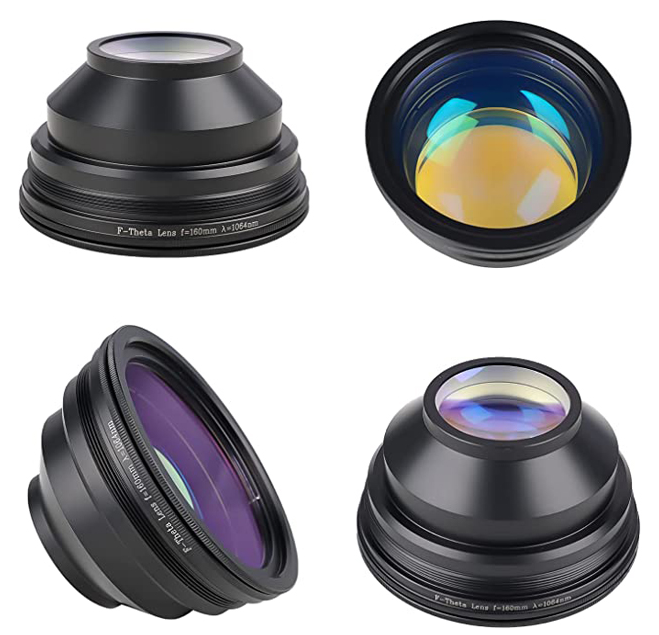The Features
The f-theta focusing field mirror, in fact, is a kind of field mirror, is designed to make the image height and scanning angle to satisfy the relationship y=f*θ lens group (θ is the angle of deflection of the galvanometer), so the f-theta mirror is also known as a linear lens. It has several features:
(1) For monochromatic light, the imaging plane for a plane, the entire image plane image quality is consistent, the aberration is small.
(2) A certain deflection speed of the incident light corresponds to a roughly constant scanning speed, so a roughly linear scan can be realized with incident light of equal angular velocity.
Knowledge of F-Theta Focusing Field Mirror Selection
The main technical parameters of field mirrors include the operating wavelength, scanning range (or focal length), and focused spot diameter.
1) Working Wavelength: The working wavelength of the field lens is determined by the laser of the marking machine. The wavelength of the fiber laser is 1064 nm, the wavelength of the CO2 laser is 10.6 um, the wavelength of the green laser is 532 nm, the wavelength of the UV laser is 355 nm, and the corresponding field lens is selected for the corresponding laser.
2) Scanning area: Focused field mirror scanning area is determined by the focal length of the focused field mirror, the focal length of the field mirror is generally only marked on the focal length, focal length and scanning area has an empirical formula: area f = 0.7 × focal length.
For example, f=160 mm field mirror corresponds to a 112 mm square, the general correction of the width of an integer is 110 mm × 110 mm, f=100 mm field mirror corresponds to a width of 70 mm × 70 mm.
3) Incident pupil: The incident pupil of the field mirror should be approximately equal to the diameter of the laser beam coming from the galvanometer. But how do we know the size of the diameter of the laser beam coming from the galvanometer? Take the smallest of two numbers: one = the outgoing spot of the laser * the multiplier of the beam expander; the other is equal to the spot number of the galvanometer.
What happens if the diameter of the laser beam coming from the galvanometer is larger than the incident pupil of the field mirror? When playing this field lens of the largest format of the pattern, the center part is no problem, the edge of the part will feel obviously much weaker light, marking depth will also be much shallower. This parameter is a lot of equipment vendors do not pay attention to, but also often make mistakes, must be careful.
4) Focusing spot diameter “d”: by the simple focusing spot formula “d” = 2fλ / D know, the longer the focal length “f”, the larger the focusing spot diameter “d”; wavelength “λ” the longer, the larger the focusing spot diameter “d”; the larger the diameter of the incident spot D, the smaller the focusing spot diameter “d”.
But how do we know how much spot a particular field mirror is focusing? There is a parameter inside the general field lens parameters: the limit of diffraction spot or called diffuse spot or called the minimum spot, this value is basically equal to the minimum value of the field lens can focus, but this value is a theoretical value, the actual value is generally larger than this value.
5) Working distance: Many customers buy field lenses and notice the focal length, but the parameter of working distance is seldom noticed. But when buying a long focal length field lens, this parameter should be paid special attention to, otherwise it is easy to make a mistake. Because many customers of the cabinet that lift column adjustment height is limited. In addition, when considering the height of the column, we also need to consider the height of the product itself, the height of the product itself is 200mm high, then the height of the corresponding column should be added to the height of the product.
6) There is a certain curved surface or high and low undulation of the product, to increase the marking width, has realized the depth of focus to meet the requirements. As we know, to hit the product with a certain curved surface or high and low ups and downs, the field lens needs to have a certain depth of focus, and if it needs to have a long depth of focus, then the corresponding focal length needs to be longer. So this time to consider the field mirror can not only look at the width, but also to take the depth of focus into account, so you need to increase the width, so the focal length increases, the corresponding depth of focus will also increase.
7) Threads for Field Mirrors. Some brands have different field mirror threads. So when you buy the field mirror, you must also figure out the thread, if you really can not find the corresponding thread of the field mirror, you can find the field mirror to do laser marking machine cabinet to do a thread conversion ring.
8) Some of the remaining parameters may also be important to note: M1 and M2 values (distance of the galvanometer lens from the field lens), scanning angle θ, size of the lens, retroreflective point (this is critical for high power systems), but these parameters are relatively little concern, and special customers may request these.
Post time: Nov-09-2023




